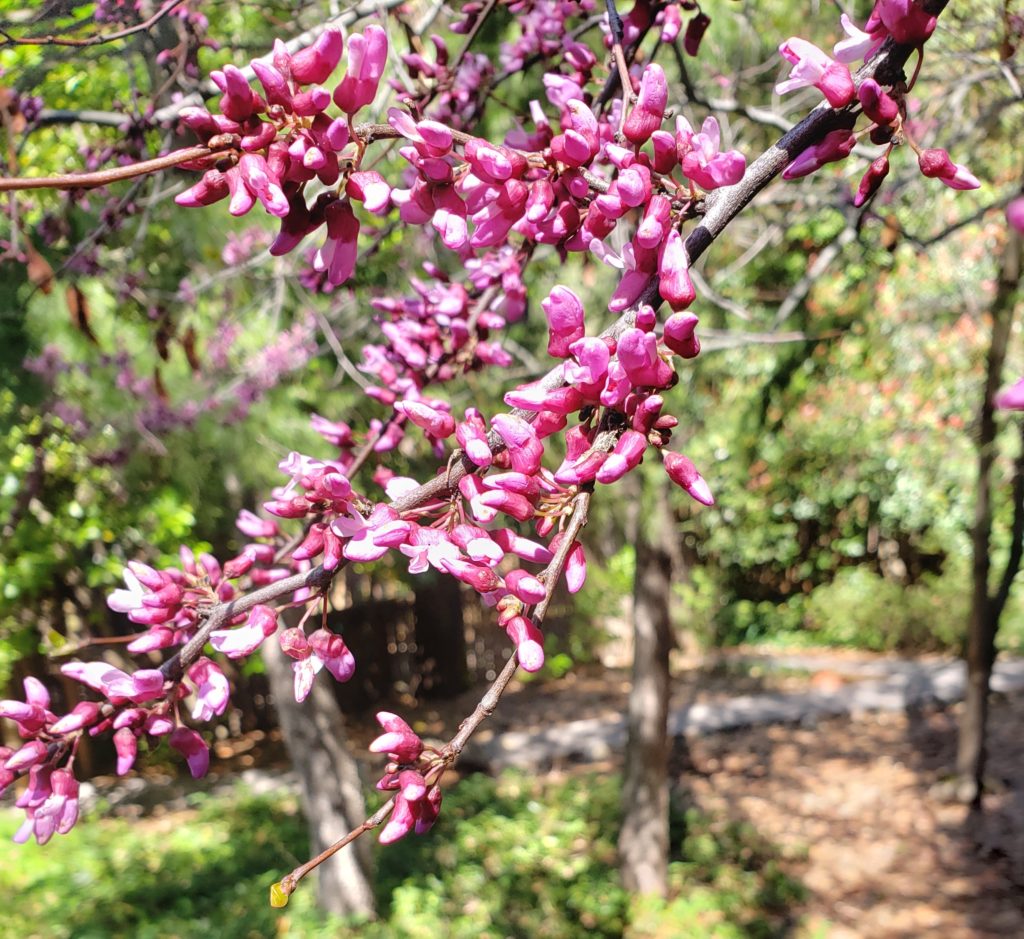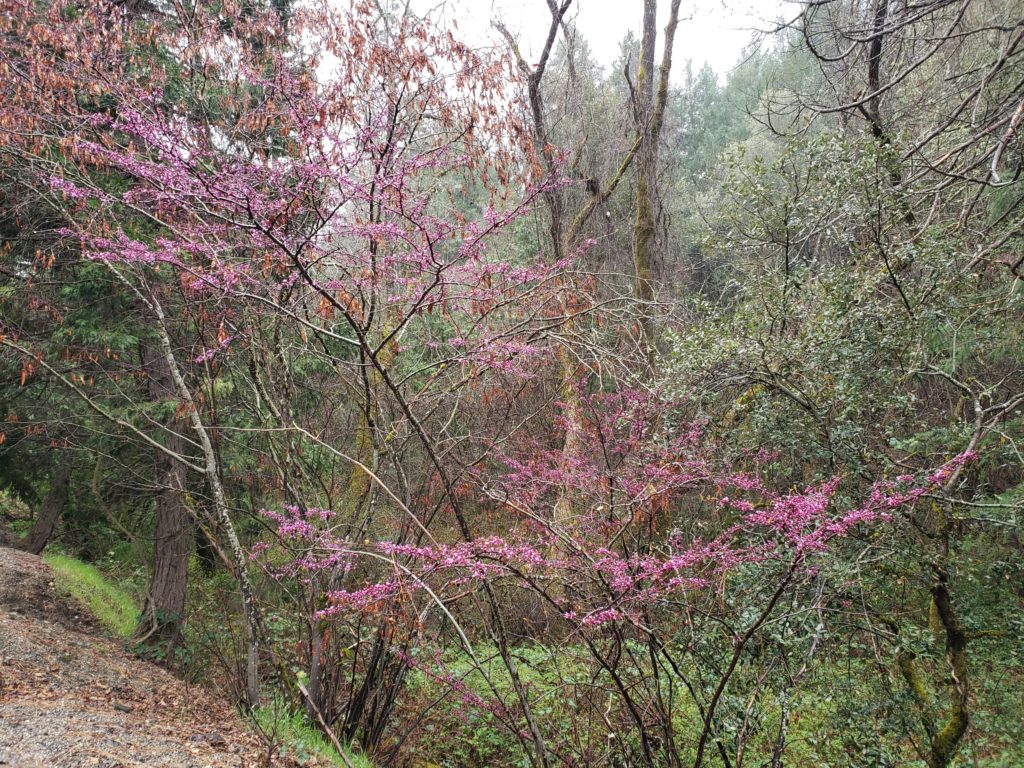The colorful, early bloom always attracts attention
Redbud has swung into full bloom over these past few weeks. I hope you’ve been able get out and see it. It’s easy to notice the brilliant, magenta-pink flowers every spring. It’s one of the first colorful trees to bloom. And this one is native, so you’ll see it out in the wild and in home landscapes.
What it’s like
It gets to 10-20 ft. tall and 10-15 ft. wide. The rounded heart-shaped leaves are a bluish-green. The leaves turn a showy yellow in the fall. It produces loads of flat pods that often hang on the tree for the fall and winter.
Redbud doesn’t need much

It takes full sun to part shade; full sun being defined as direct sun for six hours. It will bloom better with more sun, but it does appreciate a little shade. It’s good at the edge of our forest trees.
The little pea-shaped flowers cover the branches and sometimes on the trunk, making the tree’s branches and shape stand out. And they’re edible! Yes, they have a nice fresh spring-like flavor and they look beautiful in salads or appetizers.
Our native redbud (Cercis occidentalis) is very drought tolerant. It’s also called western redbud. There is an eastern redbud that looks very similar, but it needs more water. So your best bet in our dry climate is to be sure to get the western redbud.
It does need regular water the first year or two to get established. Then take it off your water schedule. If necessary, give it a few deep watering sessions in the summer. And mulch it to further reduce water needs.
It tolerates a wide range of soil, sandy to clay. But, if you plant it in clay soil be sure not to overwater it. It doesn’t like that.
It supports wildlife and pollinators
Many people like to plant colorful shrubs and trees in their yards, but they’ll often choose non-native plants. And these plants that don’t support our wildlife. I always bring this up and for more information on why and how, please see my articles on my website (see below).
As a native tree, redbud supports the wildlife in our ecosystem. Who does it support? It feeds birds, bees, hummingbirds, and the caterpillars of up to 11 butterflies and moths. That is, caterpillars and moths that either feed the birds or that go on to do some pollinating. And, further, it supports those insects that go on to feed fish, toads, frogs, and more. (See my website.)
An extra treat is that redbud is deer resistant! Although you might need to give it a little boost with Liquid Fence for a year or two, when it’s young.
Redbud benefits the soil
When you look at the flowers, you’ll notice that they are pea-shaped flowers, which means they look like the flowers of peas and beans. This indicates that the redbud is a legume. And that means that the roots host bacteria, naturally found in the soil, that take nitrogen from the atmosphere and convert it into a form that is available to plants as nutrients. This process is called nitrogen fixation. It’s done by several species of bacteria.
These bacteria form nodules on the roots of their host plants and then provide the host plant with nitrogen. When the root dies or is sloughed off, the nodules become little packets of nitrogen for other plants, enriching the soil around them.
Every ecosystem has plants that host nitrogen fixers, they help build soil fertility. Most of the nitrogen fixers are legumes. This is why organic farming and gardening practices, and old growing practices, revolve around a rotation of legumes: plants like beans, peas, and cover cops like vetch, bell beans, and the like. When the crop is harvested or turned in, the roots remain and the nodules break down, enriching the soil with nitrogen in a form that’s available to the plants.
You can prune redbud as you need
Redbud is naturally multi-trunked. But it can be trained to a single-trunked tree if desired. Just start early, select a leader and remove the other limbs.
It can also be kept smaller by cutting out the taller trunks.
In fact if you want to you can cut the tree all the way back to the ground and let it resprout. This will give you many long, fast-growing stems. This is how the native Americans created long whips for use in their basketry. The bark is a dark reddish brown and gives the baskets a beautiful accent color.
Good in a fire-prone landscape
Redbud is considered a fire-resistant tree. Not only does it resprout after a fire, but it but it can be used in a fire-wise landscape. See more about fire-wise landscaping at the Redbud Chapter of California Native Plant Society’s website at rebud-cnps.org.
Good for a variety of spots
Because it can take a bit of shade redbud is good for the edges of the forest trees we live in and around. Because of its drought tolerance, it can be planted near oaks (which should not be watered!-see that article on my website).
It makes a good specimen tree or a good backdrop for a bird or butterfly garden. It looks nice in front of a wall where the silhouette of winter branches can fill an empty space.
I do hope everyone has had a chance to get out to see the redbud bloom. It can be easily spotted along Hwy 49 heading south from Grass Valley and heading north from Nevada City starting just before the river grade.
I just came across a piece of information (eattheweeds.com) that claims that, in addition to the flowers, the pods are edible, too! But only when they are young and tender. They can be cooked, stir-fried, or eaten raw. I haven’t tried the pods yet, so I will this year as soon as they come in. I’m always game to try new wild plants. I’ll let you know how they are.

